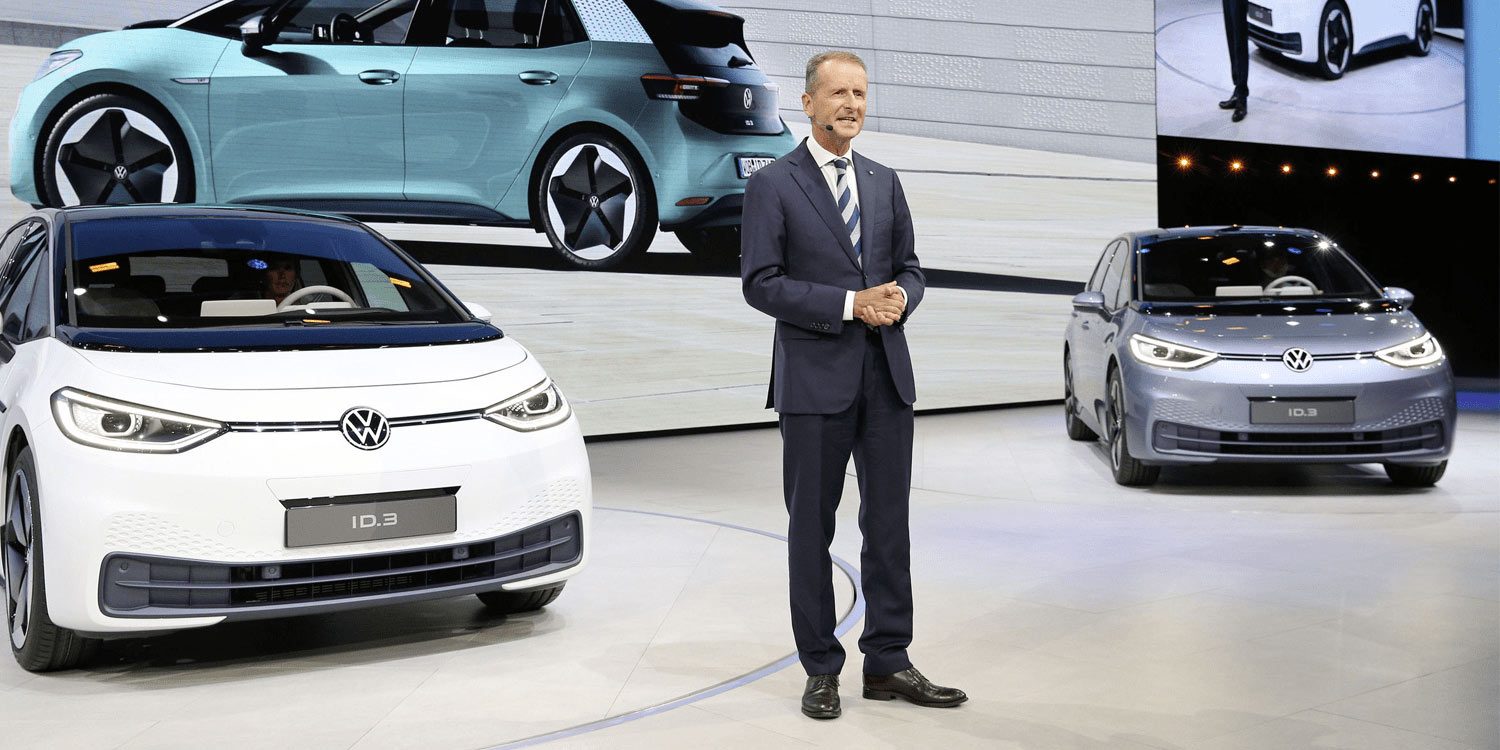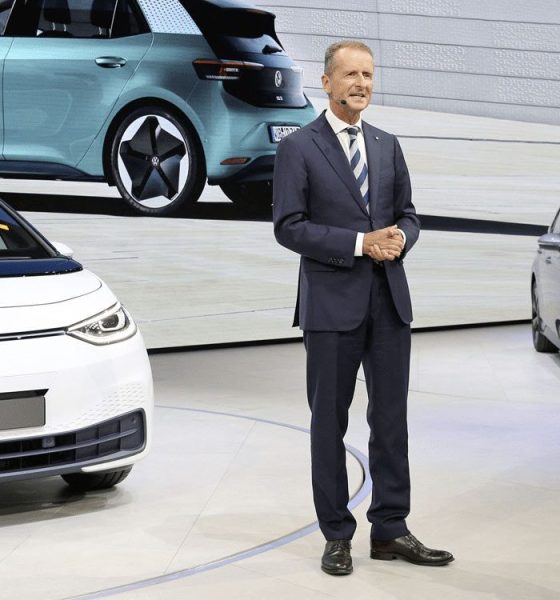

News
As Tesla rises, Volkswagen's largest shareholders back CEO's controversial EV push
As Tesla continues to rise in Europe with the construction of Giga Berlin and the impending local prduction of the Model Y, Volkswagen’s controlling family issued a rare statement of support for CEO Herbert Diess’ aggressive and somewhat controversial electric car push. In a recent statement to local German media, the Porsche-Piech family stated that they are fully backing the CEO in these trying times, as a painful shift to electric cars may be what is required to keep Volkswagen thriving in the coming EV age.
Volkswagen CEO Herbert Diess is a staunch proponent of electric cars, with the company’s first all-electric vehicle, the ID.3, being his personal project. Diess’ dedication for electric cars has earned the respect of Tesla CEO Elon Musk, who has expressed his support for the Volkswagen CEO’s efforts in the past. “Herbert Diess is doing more than any big carmaker to go electric. The good of the world should come first. For what it’s worth, he has my support,” Musk wrote.
Unfortunately for Diess, his aggressive push for electrification has faced sharp criticism. These negative sentiments have only become more prominent as Volkswagen’s ID.3 ramp met roadblocks due to the vehicle’s software. Diess has predicted these challenges, stating that Volkswagen’s shift towards electric mobility is “perhaps the most difficult task VW has ever had to face.” Yet with investors reportedly growing restless, it appeared that the Porsches and Piëchs, Volkswagen’s controlling family, have deemed it pertinent to express their stance.
In a statement to the BILD newspaper on Thursday, Supervisory Board member Hans-Michel Piëch stated that he fully supports Diess’ initiatives. “He has our support. He is faced with an enormous task. For this, he needs strength, but also support from everyone in the Group,” he said. Wolfgang Porsche, Piëch’s cousin, echoed his sentiments. “Even if Mr. Diess is criticized from many sides, he would be taking an insane risk: There is no alternative today to the path that he and the Volkswagen Board of Management have taken,” Porsche said.
Apart from openly supporting Diess’ efforts, the VW majority shareholders explained why the company had gone all-in on electric cars. For example, Diess has taken a strong stance against hydrogen, opting instead to focus solely on electric vehicles. According to Piëch, this is a decision that he and his cousin fully support. “The discussion about a decision for hydrogen or batteries alone is unfortunate. Hydrogen is too expensive for the foreseeable future and simply cannot be produced with sustainable energy,” he said.
Wolfgang Porsche, for his part, has stated that an intense focus on developing next-generation automotive solutions is needed to survive and thrive in the car industry of the future. Seemingly addressing Volkswagen’s current issues with the ID.3’s software, Porsche stated that it is better to tackle the growing pains of electrification now, instead of potentially facing a real risk in the future. “In the future, digitization and software will determine the car. You have to know: If we don’t tackle this transformation now, the company will have a huge problem in the future,” Porsche said.
The coming years will likely be historic for the automotive industry as a whole. Young carmakers such as Tesla have established a hold in the mainstream market, with vehicles such as the Model 3 becoming a viable and even preferable alternative to conventional best-sellers like the BMW M3. With legacy carmakers now realizing the value of electric cars and the importance of battery tech and software, it is in the best interest of Volkswagen to ensure that it invests in the future today. For now, this would likely result in several painful transitions. But if Diess, Piëch, and Porsche’s statements are any indication, it appears that Volkswagen will be willing to take some heavy blows if it means securing a future where the company is still relevant and competitive.
H/T Alex Voigt.

News
Tesla FSD fleet is nearing 7 billion total miles, including 2.5 billion city miles
As can be seen on Tesla’s official FSD webpage, vehicles equipped with the system have now navigated over 6.99 billion miles.

Tesla’s Full Self-Driving (Supervised) fleet is closing in on almost 7 billion total miles driven, as per data posted by the company on its official FSD webpage.
These figures hint at the massive scale of data fueling Tesla’s rapid FSD improvements, which have been quite notable as of late.
FSD mileage milestones
As can be seen on Tesla’s official FSD webpage, vehicles equipped with the system have now navigated over 6.99 billion miles. Tesla owner and avid FSD tester Whole Mars Catalog also shared a screenshot indicating that from the nearly 7 billion miles traveled by the FSD fleet, more than 2.5 billion miles were driven inside cities.
City miles are particularly valuable for complex urban scenarios like unprotected turns, pedestrian interactions, and traffic lights. This is also the difference-maker for FSD, as only complex solutions, such as Waymo’s self-driving taxis, operate similarly on inner-city streets. And even then, incidents such as the San Francisco blackouts have proven challenging for sensor-rich vehicles like Waymos.
Tesla’s data edge
Tesla has a number of advantages in the autonomous vehicle sector, one of which is the size of its fleet and the number of vehicles training FSD on real-world roads. Tesla’s nearly 7 billion FSD miles then allow the company to roll out updates that make its vehicles behave like they are being driven by experienced drivers, even if they are operating on their own.
So notable are Tesla’s improvements to FSD that NVIDIA Director of Robotics Jim Fan, after experiencing FSD v14, noted that the system is the first AI that passes what he described as a “Physical Turing Test.”
“Despite knowing exactly how robot learning works, I still find it magical watching the steering wheel turn by itself. First it feels surreal, next it becomes routine. Then, like the smartphone, taking it away actively hurts. This is how humanity gets rewired and glued to god-like technologies,” Fan wrote in a post on X.
News
Tesla starts showing how FSD will change lives in Europe
Local officials tested the system on narrow country roads and were impressed by FSD’s smooth, human-like driving, with some calling the service a game-changer for everyday life in areas that are far from urban centers.

Tesla has launched Europe’s first public shuttle service using Full Self-Driving (Supervised) in the rural Eifelkreis Bitburg-Prüm region of Germany, demonstrating how the technology can restore independence and mobility for people who struggle with limited transport options.
Local officials tested the system on narrow country roads and were impressed by FSD’s smooth, human-like driving, with some calling the service a game-changer for everyday life in areas that are far from urban centers.
Officials see real impact on rural residents
Arzfeld Mayor Johannes Kuhl and District Administrator Andreas Kruppert personally tested the Tesla shuttle service. This allowed them to see just how well FSD navigated winding lanes and rural roads confidently. Kruppert said, “Autonomous driving sounds like science fiction to many, but we simply see here that it works totally well in rural regions too.” Kuhl, for his part, also noted that FSD “feels like a very experienced driver.”
The pilot complements the area’s “Citizen Bus” program, which provides on-demand rides for elderly residents who can no longer drive themselves. Tesla Europe shared a video of a demonstration of the service, highlighting how FSD gives people their freedom back, even in places where public transport is not as prevalent.
What the Ministry for Economic Affairs and Transport says
Rhineland-Palatinate’s Minister Daniela Schmitt supported the project, praising the collaboration that made this “first of its kind in Europe” possible. As per the ministry, the rural rollout for the service shows FSD’s potential beyond major cities, and it delivers tangible benefits like grocery runs, doctor visits, and social connections for isolated residents.
“Reliable and flexible mobility is especially vital in rural areas. With the launch of a shuttle service using self-driving vehicles (FSD supervised) by Tesla in the Eifelkreis Bitburg-Prüm, an innovative pilot project is now getting underway that complements local community bus services. It is the first project of its kind in Europe.
“The result is a real gain for rural mobility: greater accessibility, more flexibility and tangible benefits for everyday life. A strong signal for innovation, cooperation and future-oriented mobility beyond urban centers,” the ministry wrote in a LinkedIn post.
News
Tesla China quietly posts Robotaxi-related job listing
Tesla China is currently seeking a Low Voltage Electrical Engineer to work on circuit board design for the company’s autonomous vehicles.

Tesla has posted a new job listing in Shanghai explicitly tied to its Robotaxi program, fueling speculation that the company is preparing to launch its dedicated autonomous ride-hailing service in China.
As noted in the listing, Tesla China is currently seeking a Low Voltage Electrical Engineer to work on circuit board design for the company’s autonomous vehicles.
Robotaxi-specific role
The listing, which was shared on social media platform X by industry watcher @tslaming, suggested that Tesla China is looking to fill the role urgently. The job listing itself specifically mentions that the person hired for the role will be working on the Low Voltage Hardware team, which would design the circuit boards that would serve as the nervous system of the Robotaxi.
Key tasks for the role, as indicated in the job listing, include collaboration with PCB layout, firmware, mechanical, program management, and validation teams, among other responsibilities. The role is based in Shanghai.
China Robotaxi launch
China represents a massive potential market for robotaxis, with its dense urban centers and supportive policies in select cities. Tesla has limited permission to roll out FSD in the country, though despite this, its vehicles have been hailed as among the best in the market when it comes to autonomous features. So far, at least, it appears that China supports Tesla’s FSD and Robotaxi rollout.
This was hinted at in November, when Tesla brought the Cybercab to the 8th China International Import Expo (CIIE) in Shanghai, marking the first time that the autonomous two-seater was brought to the Asia-Pacific region. The vehicle, despite not having a release date in China, received a significant amount of interest among the event’s attendees.








